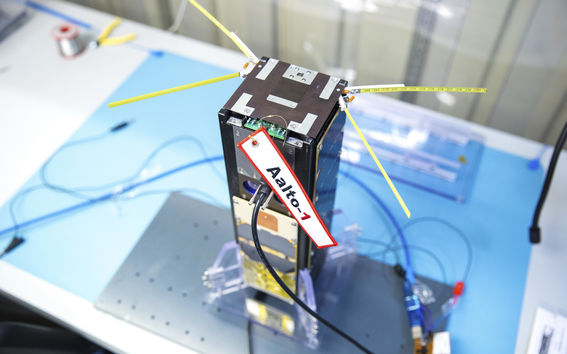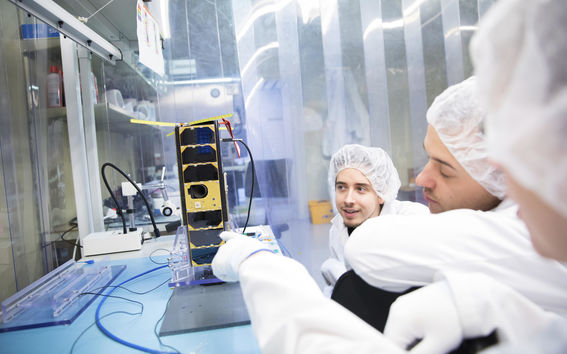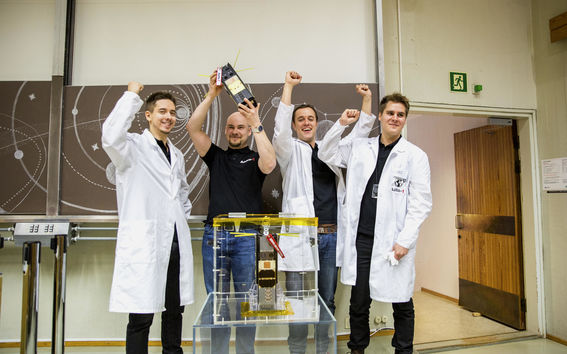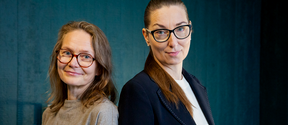Makers of the Impossible
The Makers of the Impossible exhibition showcases seven wonderful examples of actions by Aaltonians. You can explore them online or in our brand-new Marsio building on campus. Welcome!

On Midsummer Eve 2017, Finland’s first satellite, Aalto-1, built by Aalto University students, departed with a launcher to take measuring instruments completed by the Finnish Meteorological Institute, the University of Turku and VTT Technical Research Centre of Finland into orbit. The launch of the satellite initiated the space age of small satellites in Finland.
In the first days of September, this historic space voyage will come to an end when the satellite returns to the atmosphere, where friction will heat it up and burn it almost entirely to ashes. If the burning occurs in the dark, the scene will resemble a bright shooting star, just slower and longer. The Aalto-1 satellite is estimated to fly over Finland for the last time already on Monday.

It will be a nostalgic moment, admits Jaan Praks, professor of space technology at Aalto University, who has been in charge of the satellite project from the beginning.
‘At the same time, I am happy because Aalto-1 is making way for many new Finnish satellites and will not remain in the orbit as space debris,’ Praks says.
Aalto-1, which is the size of a large milk carton and weighs four kilograms, made Finnish space history in many ways. Thanks to it, Finland introduced its own Act on Space Activities and Registry of Space Objects, while also granting its first radio and operating licences for satellites. Aalto-1 was also the first Finnish space object to be included in the international Register of Objects Launched into Outer Space.
Aalto-1 attracted a young team, which sparked new interest in space and launched commercial satellite production Finland. Finland has now become a top European country in the small satellite sector, especially as a developer and manufacturer of satellites that capture images of the Earth.
‘Today, Finland already has dozens of satellites in space, and almost all of them have been built in Otaniemi. ICEYE, Kuva Space, Arctic Astronautics, Aurora Propulsion – many Finnish companies would not exist without this student project, which brought together enthusiastic future players and directed their attention towards the theme of space, Praks rejoices.

Today, the Finnish space industry is buzzing and up to a dozen satellites are built in Otaniemi every year. Most of them are commercial radar satellites manufactured by ICEYE. In addition, several institutes produce instruments for international science missions. Their roots go back to the instruments of the Aalto-1 satellite. Aalto University also participates in the development of software for the measurement systems of the European Space Agency’s Comet Interceptor and HERA satellites.
‘Aalto University is involved in the Centre of Excellence in Research of Sustainable Space and we are currently integrating the Foresail-1 Prime satellite. In addition, our student satellite team will meet at the beginning of the academic year to develop its satellite projects. If everything goes well, up to two student-led satellites may be launched into space from Aalto next year,’ says Praks.
Aalto-1 took three scientific instruments into space: an imaging spectrometer developed by VTT, a radiation detector developed jointly by the Universities of Helsinki and Turku, and a plasma brake developed by the Finnish Meteorological Institute. Development work has been ongoing for all instruments, and updated versions have been included in new space missions, for purposes such as imaging asteroids.

‘Finland entered space through cooperation. Several expert bodies, research centres and companies provided assistance in implementing the project. The payloads, or measuring instruments, of the Aalto-1 satellite were manufactured in the best Finnish institutes, often even without separate funding. Aalto’s project was mainly funded by Aalto University’s Multidisciplinary Institute of Digitalisation and Energy (MIDE), and Finnish companies and institutes participated in the procurement of the launch. A huge thank you goes out to all of them,’ Praks concludes.
VTT Technical Research Centre of Finland, the Finnish Meteorological Institute, the University of Turku and the University of Helsinki have participated in the development of the research equipment carried by the satellite. The launch of the satellite was supported by Aalto University, Nokia, Space Systems Finland (SSF), the University of Turku and RUAG Space. The project had an extensive steering group with numerous Finnish experts. In the technical development work, students were assisted by SpaceSystems Finland, RSI Solutions, IBS Berlin Space Technologies, University of Eastern Finland, University of Jyväskylä, Aboa Space Research Asro, Tartu Observatory, Clyde Space, Hyperion Technologies and Turku University of Applied Sciences.
The story of the conquerors of space has just opened in the Makers of the impossible exhibition. You can explore it online or in our brand-new Marsio building on the Otaniemi campus.

The Makers of the Impossible exhibition showcases seven wonderful examples of actions by Aaltonians. You can explore them online or in our brand-new Marsio building on campus. Welcome!

The new meeting place on Aalto University campus. Experience tomorrow!



